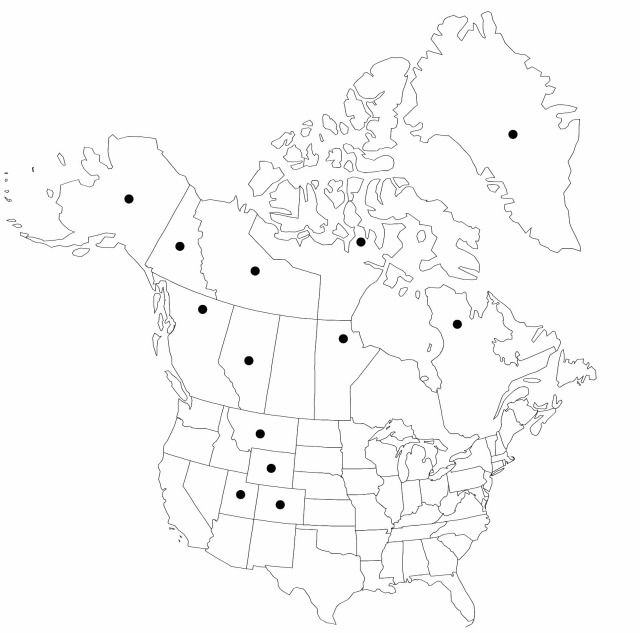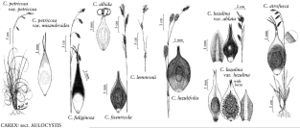Carex fuliginosa
Beschr. Riedgräs. 1: 91, plate Cc, fig. 47c. 1801.
Plants densely cespitose; rhizomes inconspicuous. Culms to 30 cm. Leaves: blades 1.5–3.5 mm wide. Inflorescences 1–12 cm, proximal internodes 5–50 mm; peduncles of proximal spikes to 5 cm; proximal bracts with blade 0–15(–40) mm, sheath cylindric, (3–)4–22 mm, mouth 0.5–1.2 mm wide. Spikes (2–)3–4(–5); lateral spikes pistillate, the proximal inclined or pendent, 6–21 × 3–6 mm; terminal spike gynecandrous, rarely staminate, pendent, 8–10 × 3.5–5 mm. Pistillate scales black or brown with pale, weak midvein and very narrowly scarious margins, ovate, 2.8–4.2 × 1.4–2.4 mm, apex obtuse to acuminate. Staminate scales brown to black with pale midvein and scarious margins, oblong-obovate to obovate, 3–5 × 1.4–1.8 mm. Anthers 1.2–2.7 mm. Perigynia ascending, pale brown proximally, black or dark brown distally, veins indistinct, lanceolate, 3.3–5.5 × 0.9–1.3(–1.4) mm, margins ciliate, glabrous; beak indistinct. Achenes obovoid, 1.5–2 × 0.9–1 mm.
Phenology: Fruiting summer.
Habitat: Tundra, screes, sedge meadows
Elevation: 50–2000 m
Distribution

Greenland, Alta., B.C., Man., N.W.T., Que., Yukon, Alaska, Colo., Mont., Utah, Wyo., Eurasia.
Discussion
W. Dietrich (1967) recognized two subspecies in the alpine and artic regions of Europe, Carex fuligonosa subsp. fuliginosa, from the mountains of central Europe, with leaves about 1/2 as long as the fertile stems and spikes 15–20(–25) mm, and subsp. misandra (R. Brown) Nyman, from northern Europe, with leaves not more than 1/3 as long as the fertile stems and spikes 10–15 mm. The North American populations have traditionally been placed in subsp. misandra, but in North America many small plants with short spikes have culms scarcely exceeding the leaves; plants with long spikes have the leaves not more than 1/4 the length of the culms.
Selected References
None.
